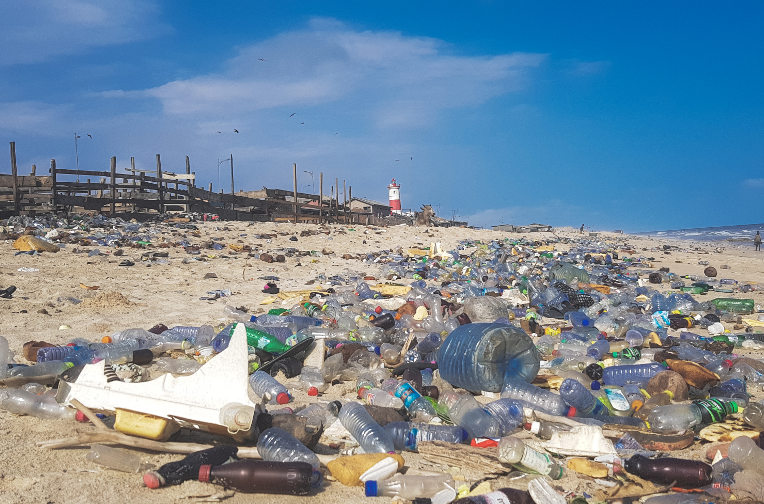Plastic: An Autobiography
By Allison Cobb
352 pp. Nightboat Books, Apr. 2021.
Paperback, $17.95; ePub, $12.99; Amazon Kindle, $10.99.
Early on in Plastic: An Autobiography, Allison Cobb recalls her fascination with a plastic-strewn Hawaiian beach. She and three others have arrived at Kamilo Beach—a site long overrun by debris from the Great Pacific Garbage Patch—after an arduous journey over miles of treacherous rock. As they approach the remote shore, brilliantly colored plastic pieces of every conceivable size and shape greet them. Cobb is well aware of the damage being done to both animal and human life by the chemicals leaching off this vast slew of toxic detritus, having spent years researching them. Still, she’s consumed by the sight, finding it “kaleidoscopic, mesmerizing.” These same words perfectly describe her book.
Plastic is a beautifully written, intricate mosaic that weaves memoir, poetry, cultural and scientific history, chemistry, biography, etymology, journalistic reportage and self-reflection into a penetrating rumination on humanity’s relationship with plastic. While many of its narratives seem unrelated at first, connections gradually appear among them. Several entries into a detailed history of the development of the hydrogen bomb, for instance, we suddenly realize the bomb’s link to modern-day plastics: namely, that its byproduct, polyethylene, is the main culprit in today’s plastic pollution predicament. Unexpected ties like this abound throughout the book. Even in chapters that don’t directly mention plastic, its presence is felt, just as plastic’s long fingers reach into every facet of our modern lives.
Cobb is a Portland, Oregon-based poet and writer for the Environmental Defense Fund whose investigation into plastic began years ago when she started collecting and cataloging plastic trash from around her neighborhood. She obsessed over this trash, regularly retrieving it from the bags where she stored it on her back porch. She studied it, arranged it into patterns and photographed it. Her exact reason for doing this eluded her; she knew only that she “wanted to understand something.” This quest for understanding is what led her to write Plastic. In the course of researching the book, she met others who shared her affinity for discarded plastic artifacts, including some who even made fine art from it.
One of Cobb’s finds, a car fender liner, captivated her above all others. Her partner dubbed it her “white whale,” and true to the moniker, it became an object of relentless obsession for Cobb. She marveled at how well it fulfilled the human needs for protection and beauty, and felt connected to it by the industrial chemicals her body shared with it. She was even moved to write poetry about it. Initially she kept it in the living room, but she later moved it to the floor by her bedside at her partner’s urging. She recalls wishing the car part could speak to her and tell her how to live on a dying planet. Thus began an “odyssey” to find out what type of car the part had come from (a Honda Odyssey, fittingly enough), who had designed it and what that person had to say about the plastic waste crisis to which the fender liner’s manufacture had contributed.
The history of plastic is a key narrative thread in Plastic. Cobb’s account of this history is illustrative rather than comprehensive, highlighting crucial moments in the development, rapid commercialization and slow creep of this supposed wonder substance into every aspect of our lives. One series of chapters engagingly combines science writing and memoir to recount the discoveries of the mid-1800s that led to the invention of the first synthetic plastic, Bakelite, in the early 1900s. Another set of chapters toward the book’s middle lucidly details the plastic industry’s concerted campaign, beginning during the postwar period, to get people into the habit of consuming ever-increasing quantities of plastic and throwing away as much of it as possible, in order to create a never-ending demand for it. We’re also given a sobering glimpse into the present and likely future state of plastic production, consumption and waste management.
World War II Navy pilot Elwyn Christman plays a prominent role in the story Cobb tells. We don’t know why this is at first, since the early chapters on him seem like a straightforward, if exciting, recounting of how he earned his Navy Cross, with little discernible connection to plastic. But eventually we discover the link, which is that his ID tag may well have been among the plastic shards found decades later by photographer and author Susan Middleton inside the stomach of a hapless dead albatross. Middleton’s and Christman’s stories are also linked by the shared motif of an egg: Just as the bombers in Christman’s squadron called their bombs eggs, someone used the same word to describe the shape Middleton made of the albatross stomach contents when staging them for her eponymous photograph.
Also at the fore of Cobb’s history of plastic are individuals, groups and inconvenient realities that have traditionally been excluded from history. Cobb is unsparing in her portraits of key figures in the advancement of plastic and nuclear weapons technology, illuminating not only their importance to history but also the many instances of misogyny and female erasure in which they bore complicity. Quoting one of the perpetrators himself, she reveals a culture of casual sexual harassment among some of the most revered figures in the Manhattan Project. She also describes numerous instances of women going uncredited for critical contributions they made to the atomic bomb project. She then attempts to “re-enflesh” these women in history through accounts of their seminal work and ideas. This is all important information, powerfully conveyed.
Another erasure Plastic seeks to redress is the suffering of nonwhite peoples around the world in the name of technological “progress.” The book tells an absorbing people’s history of U.S. nuclear testing in the Marshall Islands, enumerating a litany of horrors wrought upon the Marshallese people by the bombs’ lingering radiation. There’s also a trenchant, many-part exposé of the disproportionate impacts of plastic industry pollution on people of color, the research for which came from multiple trips to regions where majority nonwhite communities have long been living in toxic stews of industrial waste. Cobb also poignantly criticizes a museum she visited on one of her trips—one financed by an egregious industrial polluter—for its scant inclusion of women and minorities.
The information Cobb relays about the extent and harms of plastic pollution is alternately amazing and harrowing. We learn that the human population discards nearly its own weight in plastic each year, and that this plastic has so thoroughly permeated the environment that each of us now ingests a credit card’s weight in microplastics each week. As with radioactive fallout from atom bomb tests and nuclear power plant accidents, there is now plastic fallout in every corner of the planet. Microplastic is raining down from the sky, and scientists have found it everywhere from remote mountaintops to human placentas. We still have little idea of the long-term implications of all this for our species or the countless species on which our survival depends.
The steady accumulation of plastic in our bodies is, in Cobb’s view, turning us all into a new type of being, one that is part human and part plastic. Indeed, it is because Cobb perceives herself as part plastic that she feels a kinship with the car part and refers to this book as an autobiography of plastic. Nor does she believe it is solely her autobiography; she feels it could just as easily be that of any other life form, due to the universality of this fusing of living matter and plastic. “Anything alive could write this book,” she insists.
In the closing chapter, we learn what came of Cobb’s sleuthing into the origins of the Odyssey fender liner. Having determined its approximate year, having contacted the man who designed it (who declined to comment on its environmental implications) and having identified the plant that manufactured it, she travels to the plant with the car part, her daughter and partner in tow. They enter the premises under the pretense of a tour, but really they’re intent on relinquishing custody of the car part to their tour guide so it can be recycled. This is, after all, a “zero-waste” plant, Cobb reminds their flustered guide in a nice bit of Michael Moore-esque theater.
Something you won’t find in Plastic is a tacked-on, obligatory plug for solutions to our plastic crisis, for Cobb is enough of a realist to doubt our current society’s capacity for such solutions. Instead, the book’s ending lingers on the unresolved fate of that unrecyclable car part, which represents the fate of nearly all plastic produced up to now. No matter how long Cobb tries to keep it safely tucked by her bedside, one can’t escape the feeling that one day, generations from now, it will be spewing its toxic contents into the environment in some landfill or the ocean.
Photo: Plastic Pollution covering Accra beach in Ghana (2018) by Muntaka Chasant via Wikimedia Commons https://commons.wikimedia.org/wiki/File:Plastic_Pollution_in_Ghana.jpg






